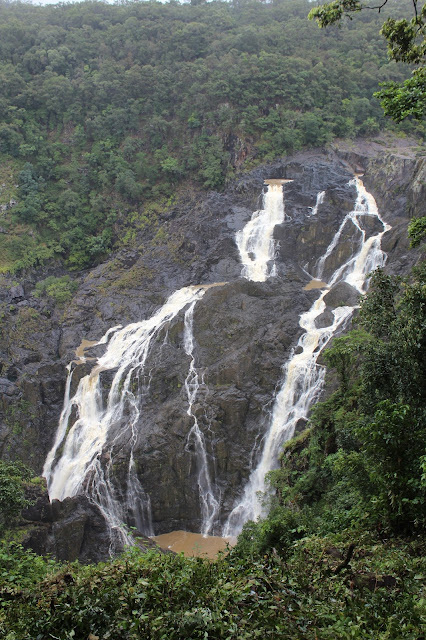 |
| Part of the group in front of Barron Falls |
 |
| Barron Falls |
Next we had an hour drive up the rainforest mountains to an
avocado producer’s orchard. The Orchard
was located 2,000 feet above Cairns and much cooler. Most of us wish we would have worn more
clothing. He has 10,000 avocado
trees. The avocado can stay on the tree
and not ripen for around 2 months after the growth. They harvest the avocados from March to June. They hand pick all the avocados and after
they are picked is when they start to ripen.
They ripen due to an enzyme breaking down the fruit. They are one of the oldest non-domesticated
trees because they have not been modified, for example an apple tree has been
modified. They are pollinated from Asian
bees. He said the reason why is because
Asian bees aren’t lazy. They bring the
bees in when need be and remove them when they have done their duty. They have a specific grading scale that gets
measured out through a machine. The
avocados then get separated into their grades and put into their specific boxes
to be shipped to their destination. He
showed us a very cool citrus tree that had lemons, limes, grapefruit, and blood
oranges. This is possible by grafting
other citrus fruits to a lemon tree. He
also grew a small forest of banana trees.
 |
| Avocado tree loaded with fruit |
 |
| Students in front of a banana tree. A first for many students. |
 |
| Colored bags on banana bunches, color coding allows managers to tell workers which bananas to harvest by bag color. |
Our next visit was to Mungalli Creek Dairy operation, where
they served us lunch. They ran a
bio-dynamic dairy. Bio-dynamic is a step
above organic with only a few differences between them, making it more
strict. They made their own yogurt,
cheese, ice cream, and used their own milk products. They also had their own free range egg
producing chickens, which they used in products and for sale. Their pastures are fertilized by a product
called 500. This is created from cow
pies buried in the ground for 6 months and then dug up. A golf ball size clump is stirred with water
to activate it and is then spread on an acre.
This makes for sturdier grasses in their pastures. They utilize rotational grazing in their
paddocks as well. They keep their dairy
cattle out on pastures and feed them a bio dynamic approved grain ration when
they are milked. They have five farms
and the parlor we saw had 120 head of cattle.
 |
| Dairy cows at the Mungalli Creek Dairy. |
As we end the day and come to the end of our amazing trip we
had our farewell dinner. We went to a
place called Dundee’s located on the harbor next to the ocean and had a very
delicious meal. We said good bye to
Bryan who helped plan the trip and toured with us. He was very helpful and informational and
will be missed.
 |
| SDSU group by Bryan Johnston, our tour guide. He was a great tour! |
Raquel and Crystal




















